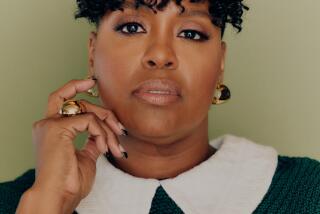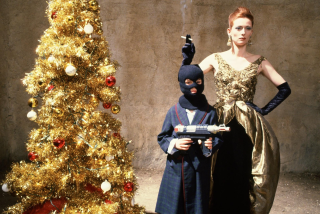Commentary: The best thing on Apple TV+? A remarkable new docuseries on LGBTQ television
- Share via
It concluded with a strange, strained meta-musical, and stumbled through a penultimate season that resembled four shows in one, but “Transparent,” Jill Soloway’s Emmy-winning portrait of a trans woman and her sprawling family, once set TV alight.
Upon its premiere in the fall of 2014, the Amazon dramedy and a handful of other recent titles — “Looking,” “Orange Is the New Black,” “American Horror Story,” “Please Like Me,” “How to Get Away With Murder” — spurred me, then six weeks into my career as a television critic, to pronounce the arrival of the “New Queer Television”: An “explosion of series engaging queer themes” as noteworthy as the movement B. Ruby Rich famously coined the New Queer Cinema.
As it turns out, my pronouncement was premature.
In Apple TV+’s remarkably thorough, astute and moving new docu-series “Visible: Out on Television,” which traces the LGBTQ imprint on the medium from the Army-McCarthy hearings to “RuPaul’s Drag Race” and “Pose,” even Soloway comes to critique “Transparent.” The series creator draws a connection between casting cis man Jeffrey Tambor to play its transgender heroine, Maura Pfefferman, and the bigotry of anti-trans “bathroom bills.” “Having Jeffrey play Maura reinforced a really dangerous stereotype that put trans people in harm’s way,” Soloway says, calling the decision “a huge mistake.”
The point isn’t to disavow “Transparent,” or even to single it out. In “Visible: Out on Television,” created by Ryan White and Jessica Hargrave (“The Keepers”), nearly every queer landmark in the medium’s life span is scrutinized, complicated, reconsidered. “Three’s Company” was “funny but grotesque,” says “Grey’s Anatomy’s” T.R. Knight. Sitcom stalwart and “Hollywood Squares” star Paul Lynde created a persona with a “punching bag” aspect, “Broad City’s” Ilana Glazer notes.
Even the epochal milestone of Ellen DeGeneres’ on-camera coming out, swiftly followed as it was by a network advisory, ratings decline and cancellation, ultimately closed “a lot of closet doors,” according to “Visible” executive producer Wanda Sykes).
Through its wide array of commentators, including executive producer (and “My So-Called Life” pioneer) Wilson Cruz and tart-tongued “Pose” impresario Billy Porter, the series is careful to outline such judgments with sympathy for the constraints of the historical context. But no compromise goes unmentioned, no offense uncritiqued — even among the lesser-known or long-forgotten entries in the annals of LGBTQ TV.
In the second of its five installments, for instance, “Visible” pauses to examine ABC’s groundbreaking made-for-television movie “That Certain Summer,” starring Hal Holbrook and Martin Sheen as a committed couple. Despite its appreciation of what such a pairing meant in 1972, the series still emphasizes that a number of observers condemned the film for language implying that homosexuality was a mental illness, as well as for showing the protagonist telling his son he would not choose to be gay if he could help it.
Nearly a half-century later, the specifics have changed, but the yearning for more queer representation on TV, and for representation that more closely resembles the lives we live, remains the same. In its final episode, “The New Guard,” “Visible” positions “The Wire’s” Omar Little and “Empire’s” Jamal Lyon as correctives to the predominantly white complexion of the medium’s gay narratives, and elucidates the problems with the precipitous, sometimes cruel deaths of queer characters on series from “Dirty Sexy Money” to “The 100.”
The LGBTQ presence on TV is at a high-water mark, “The New Guard” narrator Lena Waithe notes in conclusion, but at no point does White and Hargrave’s work suggest that there’s time to rest.
In fact, the contested nature of “Visible’s” history transforms it from a Stations-of-the-Cross valediction into a rich sociological document that’s inextricable from the political currents that have shaped the queer experience in the United States since the end of World War II.
The first use of “homosexual” on American television came amid the Lavender Scare of the 1950s. TV news failed to cover the Stonewall riots, then became an unwitting tool for disseminating the wildcat protests of ACT UP at the height of the AIDS crisis. The fight for marriage equality coincided with major breakthroughs on TV, albeit reserved primarily for white, cisgender men.
Prodding each significant development in its narrative for disappointments, shortcomings, flaws — drawing on examples from both within the industry and the wider culture — some may read the series as unnecessarily downbeat. But in resisting the temptation to see “progress” as a trend line pointed inevitably upward, “Visible” frames what progress has been made as a byproduct of struggle.
After all, retreat is never far removed from advancement: PBS declined to continue Armistead Maupin’s “Tales of the City” in 1994 after opposition from the American Family Assn. Deborah Norville warned viewers about a lesbian kiss during a segment on “The L Word” a decade later. “The Fosters” co-creator Peter Paige was called a pedophile for depicting a gay teen kiss 10 years after that.
If there is a lesson to be drawn from “Visible,” then, a moral to its medium-spanning saga, it’s the notion that the arc of the universe doesn’t bend toward justice — it is bent, shaped by the force we apply to it with our very own hands. A harmful “CBS Reports” episode, 1967’s “The Homosexuals” — a single human lifetime ago — now seems impossibly distant only because of the collective, consistent efforts of the Marsha Warfields and Mark Segals and Pedro Zamoras and Janet Mocks of the intervening years, efforts that the magic of television might otherwise erase. It is, after all, a medium defined by its refusal to show us its seams.
“Visible,” by contrast, is all seams — an extraordinary compilation of them, stitched and cross-stitched, unraveled and remade. It recognizes that the medium’s most radical transformations often come hidden in the side pocket of neglected, “feminine” forms, from queer-coded sitcoms (“The Golden Girls,” “Designing Women”) and soap operas (“All My Children”) to made-for-TV movies, daytime talk shows, reality TV. Critics unwilling to take “low” culture seriously will often miss the future staring them in the face.
What I was wrong about, labeling that moment in 2014 “the new queer television,” was not that the conditions of the art form and the industry had squared space for an unprecedented wave of queer stories. They had, and they continue to, though consolidation threatens to flatten or dilute queerness into another avenue for the commercialization of Pride.
Rather, I was wrong to imply that the moment might conceivably be a stopping point, a finish line, an achievement unlocked. Indeed, in the years since, I have often found myself frustrated by the feeling that LGBTQ television — whether counted by series, characters, special episodes, even individual scenes — never seems to reach critical mass; the wave ebbs and flows but never crests. The lesson of “Visible,” of course, is that we will not queer television, much less culture, without a fight — and that fight has no end.
We need not accept “Pose” as the only scripted series built around trans women of color. We need not burden “Looking” with the responsibility of being the one gay show on TV. We need not settle for the flashes, glimpses, echoes of queerness so often intended to placate potential critics, in lieu of the rich characters that are, for straight viewers, a matter of course.
We need not, in the end, thank Hollywood, or American culture, for deigning to reflect some minuscule part of ourselves on TV, nor need we ask for more, or for better.
We can demand it. And so we must.
More to Read
The complete guide to home viewing
Get Screen Gab for everything about the TV shows and streaming movies everyone’s talking about.
You may occasionally receive promotional content from the Los Angeles Times.







